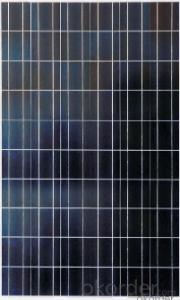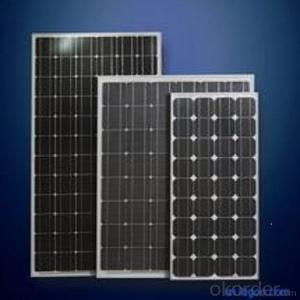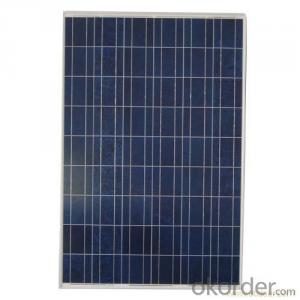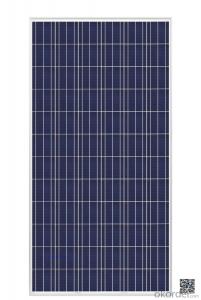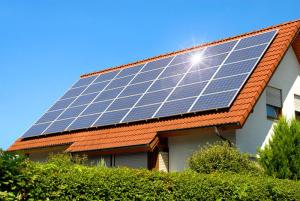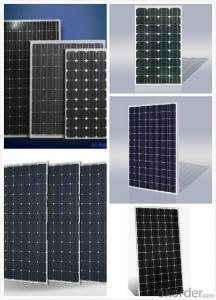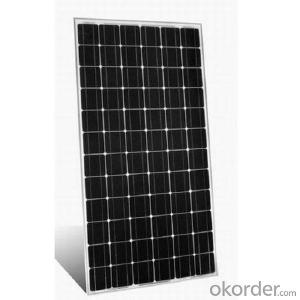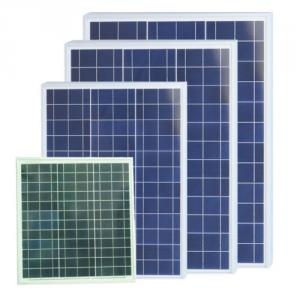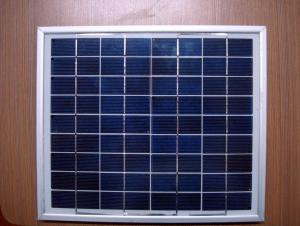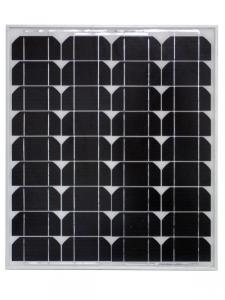Titan Solar Panels - Poly Solar Modules with Competitive Price
- Loading Port:
- Shanghai
- Payment Terms:
- TT OR LC
- Min Order Qty:
- 10 pc
- Supply Capability:
- 400000000 pc/month
OKorder Service Pledge
OKorder Financial Service
You Might Also Like
Production description:
High effi ciency, multicrystalline silicon solar cells with high transmission
and textured glass deliver a module effi ciency of up to 16.0%,
minimizing installation costs and maximizing the kWh output of your
system per unit area.
- Tight positive power tolerance of 0W to +5W ensures you receive
modules at or above nameplate power and contributes to minimizing
module mismatch losses leading to improved system yield.
- Top ranking in the “TÜV Rheinland Energy Yield Test” and the
“PHOTON Test” demonstrates high performance and annual energy
production.
Main feature:
Front cover (material / thickness) low-iron tempered glass / 3.2mm
Cell (quantity / material / dimensions /
number of busbars)
60 / multicrystalline silicon / 156mm x 156mm / 2 or 3
Encapsulant (material) ethylene vinyl acetate (EVA)
Frame (material / color / anodization color /
edge sealing) anodized aluminum alloy / silver / clear / silicone or tape
Junction box (protection degree) ≥ IP65
Cable (length / cross-sectional area) 1000mm / 4mm2
Plug connector
(type / protection degree) MC4 / IP67 or YT08-1 / IP67 or Amphenol H4 / IP68
PACKAGING SPECIFICATIONS
Number of modules per pallet 29
Number of pallets per 40' container 28
Packaging box dimensions
(L / W / H) 1700mm / 1135mm / 1165mm
Box weight 568kg
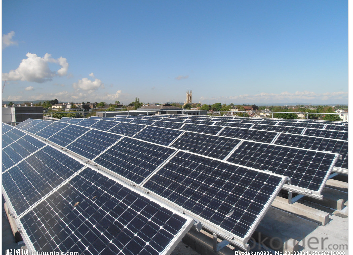
Specification:
Electrical parameters at Standard Test Conditions (STC)
Module type YLxxxP-29b (xxx=Pmax)
Power output Pmax W 260 255 250 245 240
Power output tolerances ΔPmax W 0 / + 5
Module effi ciency ηm % 16.0 15.7 15.4 15.1 14.8
Voltage at Pmax Vmpp V 30.3 30.0 29.8 29.6 29.3
Current at Pmax Impp A 8.59 8.49 8.39 8.28 8.18
Open-circuit voltage Voc V 37.7 37.7 37.6 37.5 37.5
Short-circuit current Isc A 9.09 9.01 8.92 8.83 8.75
Electrical parameters at Nominal Operating Cell Temperature (NOCT)
Power output Pmax W 189.7 186.0 182.4 178.7 175.1
Voltage at Pmax Vmpp V 27.6 27.4 27.2 27.0 26.8
Current at Pmax Impp A 6.87 6.79 6.71 6.62 6.54
Open-circuit voltage Voc V 34.8 34.8 34.7 34.6 34.6
Short-circuit current Isc A 7.35 7.28 7.21 7.14 7.07
STC: 1000W/m2 irradiance, 25°C cell temperature, AM1.5g spectrum according to EN 60904-3.
Average relative effi ciency reduction of 3.3% at 200W/m2 according to EN 60904-1.
NOCT: open-circuit module operation temperature at 800W/m2 irradiance, 20°C ambient temperature, 1m/s wind speed.
FAQ: What the advantages of CNBM?
1.CNBM is a state-owned company under jurisdiction of central goverment , one of Fortune 500 .Just because of this ,we can get more support and resources from our government.So ,it is realiable .
2.CNBM's solar products are high-qualified with TUV,UL,VDE,CE,ISO certificates. Our products ranges top in China.
3.Just as I mentioned in attahment ,we signed 500MW project with Urkan under the witness of our chairman Xi Jinping ,CNBM has ability to meet your large quantity needs,Our annual capacity is 1GW.
4.We can offer you a competitive price .Because you are our potential and valued customer .
- Q: in a solar panel, i know that the electrons are knocked loose and used as energy, what happens to the protons?
- Here okorder /... Within this structure, the electrons are not really lost from the system. An electron just gets enough energy (from light) to be able to leave its atom, and float freely around the structure. Hence you have electrons in motion, which is the definition of electric current. If the lights go out, the electrons just settle back into one of the atoms that is missing an electron.
- Q: A solar panel facing the sun at noon in mid-summer receives more intensity of the light than when it is at horizontal. However, it can receives more total solar energy when it is at horizontal than when it is tilted during a long summer day. Regradless if it is shaded by building or trees. why is that so?
- That okorder /... it shows a graph and explains it better.
- Q: How do solar panels reduce carbon emissions?
- Solar panels reduce carbon emissions by converting sunlight into electricity without burning fossil fuels. When sunlight hits the solar panels, it triggers a process called the photovoltaic effect, which generates electrical energy. This renewable energy source eliminates the need for traditional power plants that rely on burning fossil fuels, such as coal or natural gas, which release carbon dioxide and other greenhouse gases into the atmosphere. By harnessing solar energy, solar panels enable a cleaner and more sustainable electricity generation, significantly reducing carbon emissions and mitigating the harmful impacts of climate change.
- Q: Can solar panels be used for powering a marina or boating facility?
- Yes, solar panels can definitely be used to power a marina or boating facility. Solar energy can be harnessed to generate electricity that can be used to meet the power needs of various facilities and equipment in a marina or boating facility, including lighting, ventilation, pumps, and charging stations. By utilizing solar power, these facilities can reduce their reliance on conventional energy sources, decrease their carbon footprint, and potentially save on electricity costs in the long run.
- Q: If you were to shine, for example, heat lamps onto the solar panel along with the sun, will the solar panel eventually not work? Or will they produce more light as long as more light is directed onto them.
- Solar panels have a upper temperature limit, and it's only a bit more than it would reach in a very bright sunny day near the equator. Start shining heat lamps on it and you will raise it past it's max temperature, and it will die. .
- Q: How do solar panels affect the property's sustainable development goals?
- Solar panels can greatly contribute to a property's sustainable development goals by providing clean and renewable energy. By harnessing the power of the sun, solar panels reduce reliance on fossil fuels, decrease carbon emissions, and promote environmental sustainability. Additionally, the installation of solar panels can lead to long-term cost savings on electricity bills, enhancing economic sustainability. Overall, solar panels play a crucial role in advancing a property's sustainable development goals by supporting both environmental and economic sustainability.
- Q: What would these solar panels power? For instance, my energy bill shows 2035kWh for last month. How much would this remove from that if it outputted full power? Thanks!
- These panels are for small remote applications. Traffic signs, motion sensor lights, etc, where it would cost more to run an electrical line than it does to buy the panel.
- Q: Can solar panels be installed on agricultural or farming operations?
- Yes, solar panels can be installed on agricultural or farming operations. In fact, they are increasingly being adopted in these settings to generate clean and renewable energy. Solar panels can be installed on rooftops of barns, sheds, or other structures, as well as on open fields or unused land. By harnessing solar energy, farmers can reduce their electricity costs, lower their carbon footprint, and contribute to a more sustainable farming practice. Additionally, solar panels can provide shading for livestock or crops, minimizing heat stress and improving overall farm productivity.
- Q: i am very much interested in making a solar panel, my problem is where i can acquire the main components in order to build it, i am staying here in abu dhabi UAE i'm always searching on the internet for shops that can provide me a DIY kit but i did not find one, i need somebody who knows where i can get these things, please let me know.
- Build okorder
- Q: i also need to know how does a solar panel work
- solar panel convert sunlight into electricity,The controller is connected between the photovoltaic panels and batteries,it makes electricity generated from solar panels charge batteries.
Send your message to us
Titan Solar Panels - Poly Solar Modules with Competitive Price
- Loading Port:
- Shanghai
- Payment Terms:
- TT OR LC
- Min Order Qty:
- 10 pc
- Supply Capability:
- 400000000 pc/month
OKorder Service Pledge
OKorder Financial Service
Similar products
Hot products
Hot Searches
Related keywords
